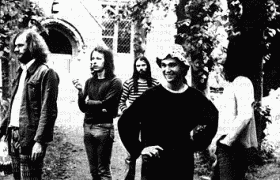
1-0 Reviews
Faust
|
Albums: |
 |
Links:
Faust: News
Well-organized fan site, with news and updates. An Incomplete Discography of Faust Fairly thorough fan site. |

|
Albums: |
 |
Links:
Faust: News
Well-organized fan site, with news and updates. An Incomplete Discography of Faust Fairly thorough fan site. |
The Faust Tapes1973
Werner Diermeier:
Hans-Joachim Irmler:
Gunter Wusthoff:
Rudolf Sosna:
Jean-Herve Peron:
with |
The Faust Tapes was not actually intended for official release, but was a collection of home recordings made by the band for friends. It was bought cheaply by the then-fledgling Virgin label, and sold for half a pound in English record shops. Incredibly, the album sold 50,000 copies, and for a time, every Tom, Dick and Mumsy was in earshot of real out-there, freakout, 100% mind-bending stuff. Talk about subversive, and the best thing about it is that it still stands up today.
This album, along with their first two official releases, makes a strong argument that rock music needn't require abundant technical proficiency or an arch concept in order to be considered progressive or avant-garde. Ultimately, it may just need a love of music, an open mind, and an eye to the future. Faust had those things in spades.
Representative tracksThe Faust Tapes: The record consists of one track with "26 passages". Some of the passages are short bursts of noise, hyped-up saxes, anarchic drums, or psychedelic echo sessions, but the majority of the music here is something else entirely. Gil Evans inspired noir-jazz, whimsical magical mystery pop, gentle acoustic guitar interludes, garage rock, funky trash RnB, pensive piano solos, found sound, telephone conversations — it's all over the map. It may sound like a lot to take in one sitting, and truthfully, if you have a distaste for experimental music, it may put you off. However, this is, at its core, fun stuff, and is certainly not 'noisy' in the manner of, say, early Boredoms (or even noisier Henry Cow). |
Faust IV1974
Diermeier, Irmler, Wusthoff, Sosna, Peron
with |
Faust's final proper release of the 70s finds the band streamlining their sound a bit, though retaining thier maverick spirit.
Today, Faust IV is a favorite of many Faust fans, but at the time it was seen as major step downwards from the frenetic whimsy of the band's early releases. The album largely eschews the cut-and-paste aesthetic of Tapes for a kind of off-center pop sensibility. This isn't exactly radio fare, but is doubtlessly less likely to drive your straight roommate insane than the earlier stuff. The group abandoned their fabled schoolhouse studio in Wümme for the major league treatment at Virgin, Ltd.'s facilities. Ironically, the quality of the recording is affected very little. It could be that the reaction to this record at the time of its release was due as much to a perceived loss of credibility than to any compromise of the band's sound.
Representative tracksKrautrock: Churning, tumbling trance rock that coined the term that was henceforth applied (with gross generalization) to a wave of experimental German bands from the early and mid-70s. This one clock in at around 12 minutes, and mines similar territory as countrymen Neu!, with washes of electronic sound thrown into a rhythmic blender, set to a repetitive spin cycle. However, this isn't quite the streamlined ambience of the other band, but rather a boisterous, almost punkish rock mantra. Julian Cope calls it "fuzzy", and that about sums it up. Picnic on a Frozen River, Deuxieme Tableaux: "Giggy Smile", mistitled. Faux-blues shuffle that is very reminiscent of early Zappa -- almost sincerely jamming down to some pretty ridiculous lyrics. Is it a parody? Can they really play? Do they really want to be Germany's ZZ Top? Anyways, midway through, the whole thing turns into a bouncy, synth-led pop vamp for no other reason than to show you they're still Faust. |
71 Minutes of Faust
1996
Diermeier, Irmler, Wusthoff, Sosna, Peron
with |
Album containing two of the band's unreleased LPs, Return of a Legend (minus one track), and Faust Party 3.
During its brief existence, Faust was remarkably prolific, releasing four albums, and recording much more. The first half of this CD is actually most of the album that was to follow Faust IV, and was released on its own as The Last LP in 1989. The music is similar to IV, with little of the collage-effect of the early albums, instead focusing on longer, often atmospheric pieces of trancerock (if not the more pop-oriented side of the band). Most of this was recorded in a hectic 1973 session at the expense of two of the members' mothers (!). The second half is comprised of the original Faust party tapes, some of which appeared on the official releases, in various forms, versions, etc. These were from 1971, and are good examples of the group's early style.
Representative tracksMunic B: Extended trance-rock piece, utilizing electronics and primal propulsion in much the same way as Babaluma-era Can. Faust never had the technical ability of that band, but manage to concoct a similarly otherworldly atmosphere -- guitar lines race relentlessly, a horn bleats Milesesque, and the whole thing gallops into darkness far sooner than you think. Party 8: Droning distorted guitars introduce a very off-center, electro-powered groove (imagine driving a car with a square wheel, and you're almost there). Anyways, the guitar pushes forward, riffing away, when it all gets smeered by a nasty vinyl rip, and the collage police enter. After a little craziness someone tries to a speech-impaired person not to "retire", and the droning takes up again. Schizo, and would Faust have it any other way? |
| TOP |
